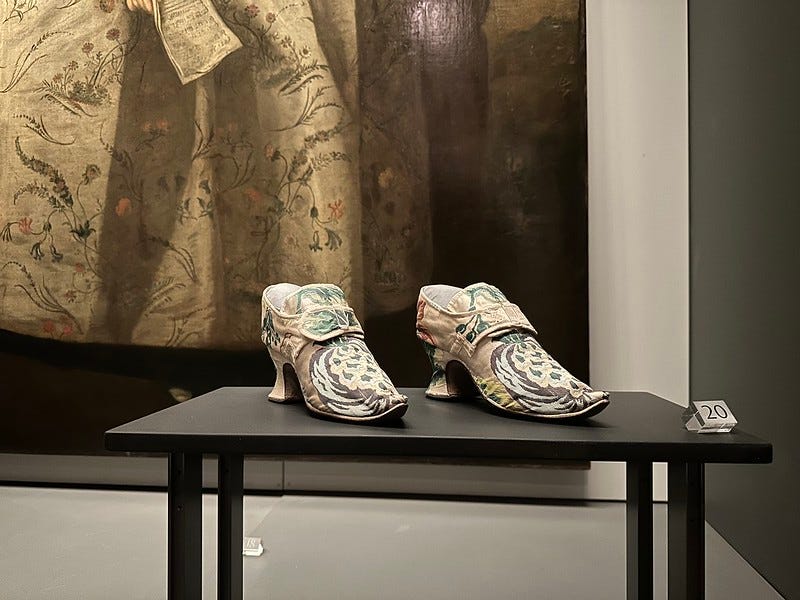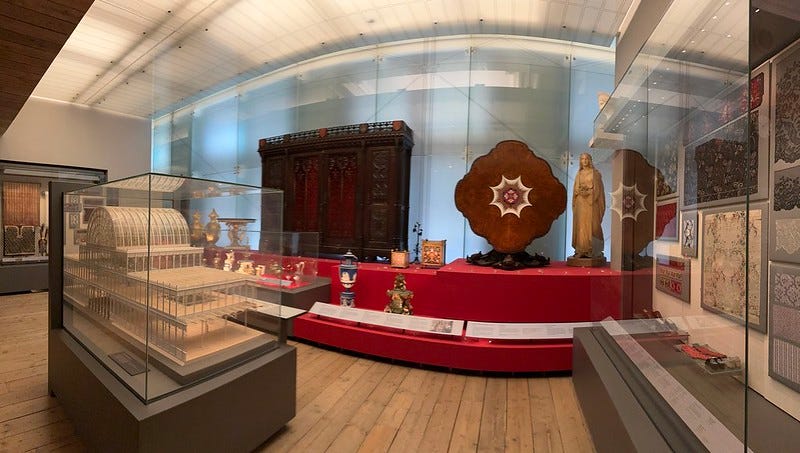Welcome to the Friday edition of Londonist: Time Machine for paying subscribers, with a chunky teaser for everyone else.
The V&A East Storehouse just opened in Hackney Wick. It sounds a bit special. I’ve not had chance to look around yet, but I have instead been back to the original museum, in my never-ending quest to find bits of old London.
That’s for the main section. First, the History Radar of upcoming events.
History Radar
Upcoming events of interest to London history fans.
🌳 GARDENS: This weekend (7-8 June) is London Open Gardens weekend, when over 100 of the capitals green spaces open their gates to the public. Many of these are in historic locations, such as Charterhouse and Marlborough House, and most cannot normally be visited. Do have a look at the programme, and perhaps see you around (I’m touring a few on Sunday).
✍️ FREE DICKENS: To celebrate its 100th birthday, the Charles Dickens Museum offers free entry for one day only on 9 June — the anniversary of the author's death. Even better, members of his own family are playing the role of museum stewards for the day, including Lucinda Hawksley (his great-great-great-granddaughter) who gives a talk about Dickens' international travels.
📸 REBEL ARCHIVISTS: On 11 June, Barbican hosts a panel talk exploring how photography, music, and storytelling help preserve London’s cultural history and keep community voices alive for future generations, and what happens to those histories when certain scenes or demographics are marginalised. The panel includes author and music journalist Aniefiok Ekpoudom, and Dr Aleema Gray, curator of 2024 exhibition Beyond The Bassline: 500 Years of Black British Music.
💂🏽♀️ KING'S BIRTHDAY PARADE: Trooping the Colour, AKA the King's Birthday Parade, takes place at Horseguards Parade on 14 June. At time of writing, there are very few tickets left, otherwise, you might catch a free glimpse if you get to The Mall or St James's Park early enough to get a good spot (or it'll be shown on BBC if you can't face the crowds). Later, at 1pm, a military flypast by the RAF whooshes over The Mall.
🇪🇸 THE SPANISH KEATS: On 15 June, Keats House in Hampstead celebrates the little-known Spanish connections to the poet John Keats. Discover the life of Fanny Keats, who married Spanish writer Valentín Llanos, shedding light on how this relationship influenced Keats's legacy. Admission to Keats House is included with your ticket.
🚶🏾♀️TOUR GUIDES: I’ve got infinite respect for tour guides… they’re always such knowledgeable, enthusiastic people. But guiding takes a lot of skill, which goes way beyond learning the local history. So I want to flag up an initiative that could do with a bit of support. Over the past 15 years, Unseen Tours has trained 29 people with experience of homelessness to become award-winning tour guides. They’ve now welcomed over 30,000 people onto tours. Their approach combines local history with powerful personal stories, challenging stigma and offering a meaningful income to people rebuilding their lives. But they need help. Unseen Tours is looking to raise £25,000 to help with training, growing the number of tours, and improving perceptions of homelessness. Take a look at their appeal, and see if you can help this wonderful cause.
Go London-Hunting in the V&A
The Victoria and Albert (V&A) museum in South Kensington is gloriously overwhelming. I’ve been at least a couple-dozen times and always find a new room. Occasionally I find a new wing. The room numbers go up to 146, which is a lot.
There are many ways to tackle this Borgesian labyrinth of art and design. Most visitors simply wander; follow their noses. Others will beeline towards the acknowledged highlights, like the Cast Courts and the ornamental cafe. But another, perhaps more rewarding way to explore is to pick a theme and seek out objects that fit. That’s what we’re going to do today. And you won’t be surprised to learn that the category is ‘London history’.
The V&A has its origins in the Great Exhibition of 1851, a tremendous display of industry, design and manufacturing, all housed inside the Crystal Palace. The profits were channelled into new developments in South Kensington, including the cluster of museums. The V&A is most like its parent, a treasure house of art and design from every corner of the world. Mixed in among it all is a wealth of material relating to London and its past. Here’s how to track it down:
1. London interiors
Britain Galleries, various rooms
Some of the V&A’s exhibits are so large that you can step inside, thereby reversing the natural order of things where, normally, you’d be looking into a cabinet from the outside. The Britain Galleries include several examples, including a sequence of rooms rescued from London’s grand houses. The largest is the white-and-gold panelled music room from Norfolk House (above). This London home of the Dukes of Norfolk stood in St James’s Square from the mid-18th century and was demolished in 1938. The space is so opulent and gilded that you half expect Lara Croft to smash through the mirror.
Elsewhere, you can saunter into a panelled room from 1606, rescued from a house in Bromley-by-Bow; and admire a a withdrawn withdrawing room of 1727 from a house on Henrietta Street, Covent Garden. This section also contains an interior wall from Northumberland House, the lion-topped pile that fronted Trafalgar Square, where Northumberland Avenue now stands.
2. A different John Rocque map
Britain Galleries (room 54)
Regular readers will know all about my project to gradually colour in John Rocque’s 1746 map of London. The great cartographer’s corpus is much deeper than that one map, however. The V&A displays one of his earliest known works, a chart of the gardens at Chiswick House, west London from 1736. I’d elaborate further, but I’m getting the urge to stop typing and colour it in… so let’s move on.
3. Spitalfields silk weavers
Britain galleries (room 52b)
These exquisite shoes are made of brocaded silk, woven long ago in the attics of Spitalfields. The area, famously, was populated by Huguenot refugees, who had fled from religious persecution in Catholic France. They brought with them expertise in weaving, and built a thriving industry from the terrace houses of Spitalfields.
Now, I’m no expert in mid-18th century women’s footwear, but even I can tell that these delicate shoes were not intended for hiking across the moors. These were status symbols, worn indoors by fashionable ladies, never to trouble the dung-stained pavements of Georgian London. The display contains other examples of Spitalfields silk weaving, including samples from Anna Maria Garthwaite, the most famous designer of flowered silks.
4. The Great Exhibition
Britain Galleries (Room 122)
As I said up top, the V&A sprang from the cast-iron loins of the Great Exhibition, and so it is no surprise to find traces of the parent dotted around the museum. The greatest collection is in the upper floor of the Britain Galleries, where a whole room is devoted to objects from the exhibition. The greatest treasure of all is architect Joseph Paxton’s original sketch for the Crystal Palace, the world-beating greenhouse that enveloped the show. Paxton worked out the structure on the back of a telegraph sheet — the original ‘back of an envelope calculation’.
5. Charlie Chaplin’s hat and cane
Theatre and Performance (Room 106)








